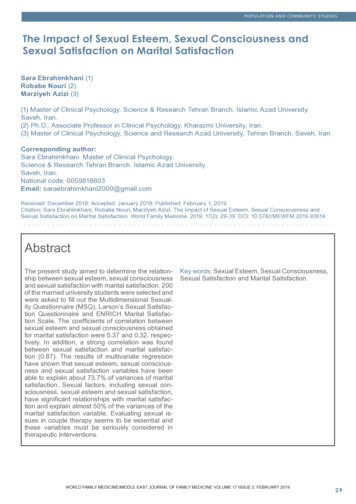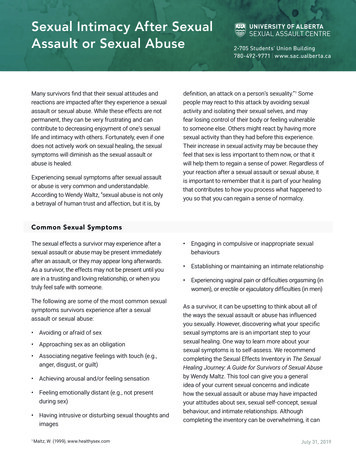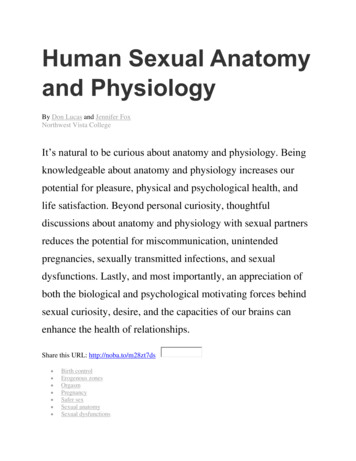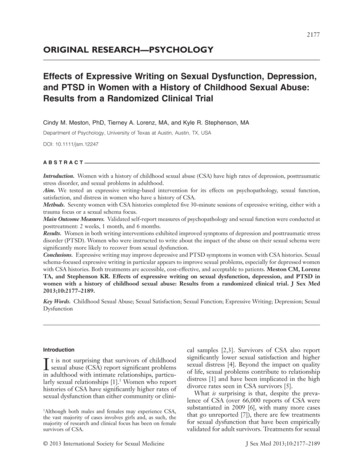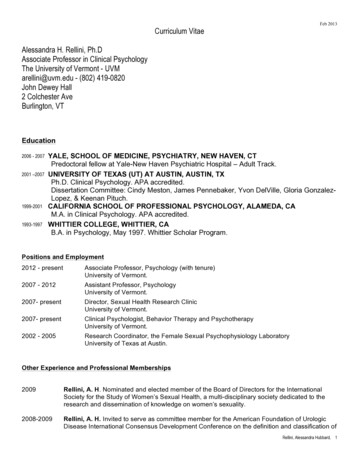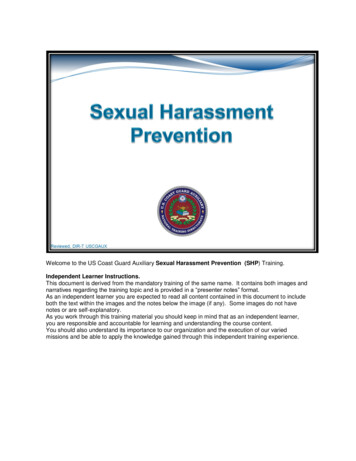
Transcription
"Writing and Sexual Difference": The Difference withinAuthor(s): Jane GallopSource: Critical Inquiry, Vol. 8, No. 4 (Summer, 1982), pp. 797-804Published by: The University of Chicago PressStable URL: http://www.jstor.org/stable/1343198 .Accessed: 03/02/2014 14:09Your use of the JSTOR archive indicates your acceptance of the Terms & Conditions of Use, available at ms.jsp.JSTOR is a not-for-profit service that helps scholars, researchers, and students discover, use, and build upon a wide range ofcontent in a trusted digital archive. We use information technology and tools to increase productivity and facilitate new formsof scholarship. For more information about JSTOR, please contact support@jstor.org.The University of Chicago Press is collaborating with JSTOR to digitize, preserve and extend access to CriticalInquiry.http://www.jstor.orgThis content downloaded from 131.252.96.28 on Mon, 3 Feb 2014 14:09:39 PMAll use subject to JSTOR Terms and Conditions
Critical ResponseIWriting and Sexual Difference:The Difference WithinJane GallopThe Winter 1981 issue of CriticalInquiry (vol. 8, no. 2) is entitledWritingand Sexual Difference and is guest edited by Elizabeth Abel. Her introduction concludes thus: "In addition to refining our mythologies of difference, this moment of feminist inquiry allows new figures to provide adifferent and enabling mythology" (p. 178). In "this moment," winter1981, CriticalInquiry has become "feminist inquiry," and the momentarysubstitution of terms--"feminist" for "critical"-allows new figures (theguest editor, for example) to provide a different and en-Abel-ingmythology.The word "mythology" might remind us that, in the same issue,Nina Auerbach celebrates how the poet H. D. aimed "to metamorphosethe woman's selfhood into an infinitely shifting myth" (p. 298). Later inthe issue, Judith Kegan Gardiner-whosework is very close toAbel's'-writes that "the woman writer uses her text . . as part of acontinuing process involving her own self-definition" (p. 357). According to Gardiner, the autobiographical critical essay is one manifestationof the tendency in women's writing to "blur the public and private," atendency which stems from the "continual crossing of self and other"that is peculiar to female psychology (p. 355).My reading of the "autobiographical" component in Abel's editor1. This can be deduced from evidence internal to the issue. Elaine Showalter says thatAbel applies Nancy Chodorow's theory to contemporary women's novels (see "FeministCriticism in the Wilderness," pp. 196-97). This is essentially what Gardiner does in hercontribution to the issue. Not only is the work of these two women close, but they work on thecloseness between women.Ci(tical Inquiry 8 (Summer 1982)k 1982 by The University of Chicago. 0093-1896/82/0804-0007 01.00.All rights reserved.797This content downloaded from 131.252.96.28 on Mon, 3 Feb 2014 14:09:39 PMAll use subject to JSTOR Terms and Conditions
798Critical ResponseJane Gallopship might lay it open to accusations of self-indulgence if it were not that,with a "continual crossing of self and other," it becomes quite difficult topin down the self that is being indulged.2 In other words, there is analien presence within Abel's text which makes it impossible for her to"use" it as Gardiner suggests a woman does. Just as Abel and Gardiner,following Nancy Chodorow, see the woman's self as inextricably mixedup with the identity of another woman (the mother), so too the alienpresence within Abel's moment is the text of another woman. The otherwoman's name is Barbara Johnson. A quotation from Johnson's bookThe Critical Difference appears as the epigraph to the editor's introduction. If the substitution of "feminist" for "critical"allows an en-Abel-ing,the epigraph already occasions a return of the dethroned term "critical."There is one other mention of Johnson and CriticalDifference in theissue. Mary Jacobus describes a "love language between two women" as"a language of desire whose object . . . is that internal (in)differencewhich, in another context, Barbara Johnson calls 'not a difference between . but a difference within. Far from constituting the text's uniqueidentity, it is that which subverts the very idea of identity' " (pp. 220-21).Writing about this internal difference, Jacobus enacts it. Johnson'swords, although within Jacobus' text, remain marked as different,marked as belonging to "another context." In its position as epigraph,The Critical Difference functions precisely as such a dis-Abel-ing "difference within" the entire issue.The beginning of the epigraph promises to repeat a commonplaceabout literature and sex: "If human beings were not divided into twobiological sexes, there would probably be no need for literature. And ifliterature could truly say what the relations between the sexes are, wewould doubtless not need much of it then, either." At this point, Abelelides part of Johnson's text, and on the other side of the elision weencounter a quite startling formulation which reverses the terms of theexpected truism: "It is not the life of sexuality that literature cannotcapture; it is literature that inhabits the very heart of what makes sexuality problematic for us speaking animals." Sexual difference is a mystery;literature is concerned with that mystery. The reader expects another2. It is, of course, not literally autobiographical but rather auto-graphical, a writing ofthe self. Nor do I mean to suggest that Abel consciously intends to write her name into thenew mythology. What I wish to get at through this play on words is what we might call thetext's unconscious. My hope is that attention to such marginal yet symptomatic momentsmight uncover some powerful, but not explicitly thematized, forces in the text.Jane Gallop, associate professor of French at Miami University, isthe author of Intersections:A Reading of Sade with Bataille, Blanchot, andKlossowskiand The Daughter'sSeduction:Feminismand Psychoanalysis.She iscurrently at work on a book on Jacques Lacan's Ecrits.This content downloaded from 131.252.96.28 on Mon, 3 Feb 2014 14:09:39 PMAll use subject to JSTOR Terms and Conditions
Critical InquirySummer1982799rendition of the refrain that literature is unable to "capture" the mysteryof sex, but instead Johnson claims that literature is already at the heart ofwhat constitutes sex as enigma. Literature could be called the differencewithin sexuality.This is very puzzling, very hard to understand. Abel says nothing inthe introduction to explain it, and nothing in the issue explicitly serves toassimilate this internal difference. But because of it, from the very firstpage, Writing and Sexual Difference (the title) becomes troubling. Does"sexual difference" mean the differencebetweenthe sexes or the differencewithin sex? Are "sexual difference" and "writing" two distinct domainswhich intersect, or is writing interior to sexual difference?Johnson's puzzling remark could best be explained by recourse toLacanian psychoanalysis. According to Jacques Lacan, desire springsfrom the fact that the articulated demand always necessarily exceeds theinstinctual needs one might wish to communicate.3 The common view ofwhich underwrites the expected refrain about literalanguage-thatture's inadequacy to capture sex-is that language is inadequate to express human needs. But according to Lacan, language is not onlyadequate but overabundant: it presents a surplus. In a formulationcloser to Johnson's, Jean Laplanche, another French psychoanalyst,writes that sexual excitation is an "alien internal entity" and that thisentity is precisely "parental fantasies and above all maternal fantasies."4If we understand fantasies as a form of literature, then sexual excitation,for Laplanche, is the alien internal presence of literature.My attempt to explain Johnson's provocative remark is far fromsatisfactory, but even this cursory gesture demonstrates that any assimilation of these words necessitates a foray into "another context." Myconcern here, however, is not with what the epigraph might mean in thecontext of Johnson's book but rather with its effect within the bounds ofthe Winter 1981 issue of Critical Inquiry. Earlier, via Chodorow, I compared The Critical Difference within the "feminist inquiry" to the motherinternal to the daughter's self; now I would construe it as a maternalfantasy, an unassimilated internal difference which, like sex itself,creates a tension, an instability, a subversion of identity, threatening, forexample, the identity "feminist."In the introduction Abel writes, "The analysis of female talentgrappling with a male tradition translates sexual difference into literarydifferences" (p. 174). Literary difference is a "translation" of sexualdifference which is, by implication, an original. This suggests the standard model in which sexuality is prior to literature, whereas the epigraph enigmatically implies that literature is already operative within3. See Jacques Lacan, "The Signification of the Phallus," Ecrits: A Selection, trans.Alan A. Sheridan (New York, 1977), pp. 286-87.4. Jean Laplanche, Life and Death in Psychoanalysis,trans. Jeffrey Mehlman (Baltimore,1976), p. 24.This content downloaded from 131.252.96.28 on Mon, 3 Feb 2014 14:09:39 PMAll use subject to JSTOR Terms and Conditions
800Critical ResponseJane Gallopsexuality. But "translation" is also a potentially resonant term in thenetwork of disabling internal alterity which I am here attempting totrace.Although Johnson is mentioned only twice in the issue, her namedoes make one other appearance between its covers. In the pages ofadvertising at the end of the journal, in the ad for CriticalInquiry's ownpublisher, the University of Chicago Press, we read that Johnson hastranslated Jacques Derrida's Dissemination. From the biographical noteson the contributors, we learn that the issue includes another translator ofDerrida, Gayatri Chakravorty Spivak. Moreover, Spivak's contribution isitself a translation.Spivak translates the Bengali story "Draupadi," written byMahasveta Devi. Within the issue, the story occasions some uncertaintyabout the authority of original over translation: both in the table ofcontents and in the running heads, Spivak's name appears in the position of author. The editor's introduction, as we have seen, links thepriority of original over translation with the anteriority of sexuality toliterature. Not only does "Draupadi" call into question the authority ofthe original, it also raises the question of what is sexuality, or what is thebody, outside of or anterior to literature.Abel writes that "the fragmented female body shifts from metaphorto fact. 'Draupadi' lays bare the physical violence sublimated inmetaphors of textual production" (p. 177). "From metaphor to fact": itlooks like the Bengali story is going to take the journal from literature tolife, to the real body, the real world, outside of rhetoric. This shift frommetaphor to fact is in fact, however, a shift from nonfiction to fiction."Draupadi" is the only piece of fiction in the issue; so when Abel says weswitch from metaphor to fact, we must take "fact" as a metaphor.Abel writes "the fragmented female body," but Draupadi (theheroine of the story) is not literally fragmented but rather mutilated.The metaphorical use of "fragmented" serves to link the story withNancy J. Vickers' article on the Petrarchan tradition of fragmentarydescriptions of the female body. According to Vickers, Petrarch'srhetorical fragmentation of Laura's body reverses the classical myth ofthe literal fragmentation of Actaeon as punishment for his view of Diana's naked body. One could say that "Draupadi" reverses the reversal:the naked female body, albeit mutilated, has once again the power tothreaten the male.Although Abel presents the story as a break with the rest of thevolume, a shift "from West to East, . from implicit to explicit politicalperspective" (p. 177), she also sutures this break. Moreover, she links theBengali story to probably the most traditional criticism in the volume, astudy of variations on a classical myth in Renaissance poetry. Petrarchand Ovid might be said to represent the mainstream of our Westerntradition, and yet they are linked to this gesture outside. Rather thanThis content downloaded from 131.252.96.28 on Mon, 3 Feb 2014 14:09:39 PMAll use subject to JSTOR Terms and Conditions
Critical InquirySummer1982801simply dismissing this link as an imperialistic appropriation, might wenot also see this resemblance between the exotic other and the very heartof the same as another manifestation of the difference within?Continuing my analysis of Abel's statement about "Draupadi," Iread the phrase " 'Draupadi' lays bare the physical violence" as a piece ofblack humor when I recall that in the story the heroine, after beingmultiply raped and mutilated, tears up her clothes and refuses to coverher mangled, bleeding body. She literally "lays bare the physical violence," which then reminds us that Abel is not using the phrase literallybut figuratively. Abel's sentence implies that metaphor is a "cloth" veilingphysical violence and that to expose violence demands that we tear themetaphor, render it inoperative, as Draupadi does her "cloth." Yet inorder to speak this violent literalization, she necessarily has recourse tometaphor. In fact, the play on "Draupadi" as title and Draupadi ascharacter allows us to see Draupadi's defiant exhibition after her rape asan allegory or a metaphor for reading, for a certain kind of ideologicalcriticism.At the very moment when she would proclaim the shift frommetaphor to fact, the feminist critic cannot help but produce metaphors.I say "the feminist critic," rather than "Abel" because this is a momentthat recurs in various texts of this issue, the moment when, in reachingfor some nonrhetorical body, some referential body to ground sexualdifference outside of writing, the critic produces a rhetorical use of thebody as metaphor for the nonrhetorical.At the beginning of her article on the lesbian novel, Catharine R.Stimpson states that her "definition of the lesbian . will be conservativeand severely literal." We are prepared for the nonrhetorical, a shift fromliterary metaphor to sexual fact. It turns out that the "severely literal" isthe domain of the body: "She is a woman who finds other women erotically attractive and gratifying. Of course a lesbian is more than her body,more than her flesh, but lesbianism partakes of the body, partakes of theflesh" (p. 364). Although the phrase "finds other women erotically attractive and gratifying" is vague and does not necessarily denote anyspecific activity, Stimpson is somewhat apologetic about her restriction ofthe lesbian to the body: "of course she is more" but. . . . Yet we havebeen warned that she will be "conservative" and severe, that we mightnot find her definition gratifying."Partakes of the body, partakes of the flesh" is still quite vague. Sheneeds to go on and make it clear what she does and does not mean:"That carnality distinguishes it from gestures of political sympathy withhomosexuals and from affectionate friendships in which women enjoyeach other, support each other, and commingle a sense of identity andwell-being. Lesbianism represents a commitment of skin, blood, breast,and bone" (p. 364). She is quite specific about what she does not mean.Political sympathy and affectionate friendships are excluded from theThis content downloaded from 131.252.96.28 on Mon, 3 Feb 2014 14:09:39 PMAll use subject to JSTOR Terms and Conditions
802Critical ResponseJane Gallopliteral definition, however severe we might find that exclusion. They areonly figuratively or symbolically lesbian. Literal lesbianism is "a commitment of skin, blood, breast, and bone." Actually Stimpson writes that"lesbianism represents" this commitment, that is, lesbianism symbolizesit. The literal definition turns out to give a figurative sense of lesbianism.Moreover, what it symbolizes is "a commitment of skin, blood, breast,and bone"; that is, it symbolizes something that is already rhetorical. Areany of these items literally committed? How, and to what or to whom?Not only is the list highly alliterative but each of the terms has a longhistory of metaphoric use. She does not include more shocking, moreseverely unliterary terms such as kidney or even clitoris. Despite herproclamation of severe literality, her definition ultimately remains withinthe rhetorical tradition for designating the body. This implicit contradiction has potentially far-reaching implications for an article that, onthe one hand, decries a tradition of oppression that has kept the lesbianfrom directly and explicitly "naming her experience" and yet finallyregrets that the lesbian and feminist press is ignorant of literary traditions and rejects novels that are too literary.Elaine Showalter has other sorts of problems with the metaphor ofthe body. She writes: "While feminist criticism rejects the attribution ofliteral biological inferiority, some theorists seem to have accepted themetaphorical implications of female biological difference in writing."Again the literal and the metaphoric body are at stake. A question fromSandra Gilbert and Susan Gubar's Madwomanin theAttic seems a point offocus for Showalter's discomfort: "'If the pen is a metaphorical penis,from what organ can females generate texts?' " (p. 187).Showalter gives a derisive, dismissive answer to the question: "critics. like myself. might reply that women generate texts from the brainor that the word-processor of the near future, with its compactly codedmicrochips, its inputs and outputs, is a metaphorical womb" (p. 187). Butthe dismissal does not work; the question returns to haunt her text,appearing in two nervously jocular parentheses: "(If to write ismetaphorically to give birth, from what organ can males generatetexts?)"; "(could this [the bladder] be the organ from which femalesgenerate texts?)" (pp. 188, 194). I submit that the persistence of thisquestion bespeaks a difficulty in accepting the body as metaphor, a demand that metaphors of the body be read literally. This difficulty withbodily metaphors has various important implications. For example,although she recognizes that Lacanian psychoanalysis uses castration as a"total metaphor" for the subject's relation to language, she misconstruesit as only referring to the female subject, thereby assuming that "castration" even as metaphor must still refer to the literal lack of male organs(p. 194).An example of some sort of trouble around literal and metaphoricbodies might be found in almost any of the articles in Writing and SexualThis content downloaded from 131.252.96.28 on Mon, 3 Feb 2014 14:09:39 PMAll use subject to JSTOR Terms and Conditions
Critical InquirySummer1982803Difference. I would say that the metaphoricity of the body, what appearsin this context as the inescapable metaphoricity of the body, comes closeto Johnson's statement that literature inhabits the very heart of sexuality.At the moment when Stimpson, for example, would separate the sexuallife from literature and turn to the purely flesh, she willy-nilly producesmore literature.Yet must we then conclude that the literal body, the real world, is noconcern of the critic, that everything is metaphor or rhetoric or literature? This bodes ill for feminist criticism or indeed any nonformalistcriticism. It seems to argue for apolitical criticism which has historicallybeen politically conservative.Abel suggests that we read formalistic differences as translations ofsexual difference. Translation, like metaphor, is imbued with the difference within, for it is never simply itself but must represent anothertext and thus includes another within its identity. Not only is literature atthe heart of sexual difference, but sexual difference is at the heart ofliterature as the absent original to which the translation must refer. Iwould accept the statement that literature is a translation of sexuality if Icould add that we have no direct access to the original, that the best weever have available is a good translation. Perhaps that is the purport ofSpivak's name in the place for the author.Abel endorses Spivak's contribution to the issue as not only an explicit difference within but an unsettling one: "With this story the volume shifts from West to East, from criticism to fiction, from implicit toexplicit political perspective . Our interpretative strategies should beshaken by Draupadi" (pp. 177-78). Yet what is perhaps most unsettlingabout this text is not the shift from metaphor to fact but rather that theswitch to an explicit political perspective corresponds to a switch fromnonfiction to fiction.I have identified two alien internal presences in Writing and SexualDifference: one explicitly recognized and celebrated as foreign and unsettling, the other pursuing her subversive effect in silence. They wouldseem to be not only at opposite ends of the volume but also at oppositeends of a spectrum. "Draupadi" is literature; the epigraph, not evencriticism but rarefied theory. The Bengali story is explicitly political, notjust feminist but Third World revolutionary; Johnson's statements findtheir context in the most esoteric achievements of First World thoughtand would seem to deny feminism and other real-world concerns infavor of a formalistic concern with literature. Yet there might be, despitetheir blatant opposition, some similarity between these poles, like redand violet on the color spectrum.The epigraph and the final entry ("Draupadi") could be said torepresent the two allegiances between which "this moment of feministinquiry" is torn: the literary and the political. Abel writes in her introduction that "concern with textual conventions dispels one litany ofThis content downloaded from 131.252.96.28 on Mon, 3 Feb 2014 14:09:39 PMAll use subject to JSTOR Terms and Conditions
804Critical ResponseJane Gallopfamiliar accusations: reductiveness, dogmatism, insensitivity to literaryvalues. Such sophisticated reading.may also generate a litany ofnew accusations: that textuality is simply a return to formalism; thatfeminist critics have betrayed [their] political commitments" (p. 174).The repeated phrase "litany of accusations" is the tip-off that thefeminist critic's relations to these two stern authorities are structurallythe same. Like the child whose two parents have differing values, she iscaught in a balancing act, trying to stave off disapproval on two fronts.Although Showalter suggests that we choose political commitmentand stop trying to please the "white fathers" of literary criticism, she alsopresents a model of the girl's necessary balancing act: "If a man's text .is fathered, then a woman's text is not only mothered but parented; itconfronts both maternal and paternal precursors and must deal with theproblems and advantages of both lines of inheritance" (p. 203). In ourculture, we have a singular identity, one name, the name of the father.For the purpose of consolidating an identity, one-half of our parentageis denied.That one is the child of two parents is another way of formulatingthe difference within. The feminist critic in her inheritance from bothfeminism and criticism lives the at once enabling and disabling tension ofa difference within. We write in sexual difference. That is the criticaldifference in feminist inquiry.This content downloaded from 131.252.96.28 on Mon, 3 Feb 2014 14:09:39 PMAll use subject to JSTOR Terms and Conditions
"Writing and Sexual Difference": The Difference within Author(s): Jane Gallop . fantasy, an unassimilated internal difference which, like sex itself, creates a tension, an instability, a subversion of identity, threatening, for example, the identity "feminist." In the introduction Abel writes, "The analysis of female talent .


